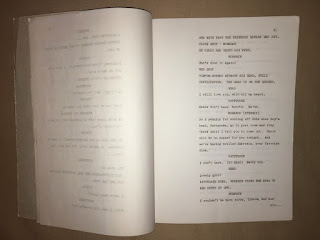 The idea put forth in the pamphlet is that Groucho would play a contemporary family man, who escapes to the Land of Mo when everyday pressures become too heavy. It says that a script is being written by Frank Gabrielson in collaboration with Robert Dwan. Gabrielson had already adapted The Marvelous Land of Oz
for Shirley Temple, as well as creating a stage version of The Wizard of Oz that was used for many years by various theaters. Dwan was the director and editor of Groucho's
quiz show You Bet Your Life. His role was to "...help tailor the title
role for Groucho's unique and flamboyant talents...". A script written by Gore Vidal is mentioned as something that may be integrated into this concept. But the script by Vidal is really a straightforward fairy tale, and fairly faithful to the source material. There's nothing to indicate that it was intended for Groucho, or the concept outlined in the pamphlet.
The idea put forth in the pamphlet is that Groucho would play a contemporary family man, who escapes to the Land of Mo when everyday pressures become too heavy. It says that a script is being written by Frank Gabrielson in collaboration with Robert Dwan. Gabrielson had already adapted The Marvelous Land of Oz
for Shirley Temple, as well as creating a stage version of The Wizard of Oz that was used for many years by various theaters. Dwan was the director and editor of Groucho's
quiz show You Bet Your Life. His role was to "...help tailor the title
role for Groucho's unique and flamboyant talents...". A script written by Gore Vidal is mentioned as something that may be integrated into this concept. But the script by Vidal is really a straightforward fairy tale, and fairly faithful to the source material. There's nothing to indicate that it was intended for Groucho, or the concept outlined in the pamphlet. In the script, we are introduced to the Magical Monarch, who is also referred to simply as Mo. He introduces us to his country, and his daughter Pattycake who has lost her temper. In Mo, we are told, everyone keeps their temper (which resembles a square cut jewel) in a locket. After Pattycake runs off to fetch an axe, in order to cut down a hat tree that has offended her by growing last season's hats, we are introduced to Timtom. He is a young hunter who is in love with the princess. When he declares his love, she cuts off his head with the axe intended for the tree. The Monarch restores Timtom's head, backwards at first, and Timtom declares his intention to marry the princess.
In the script, we are introduced to the Magical Monarch, who is also referred to simply as Mo. He introduces us to his country, and his daughter Pattycake who has lost her temper. In Mo, we are told, everyone keeps their temper (which resembles a square cut jewel) in a locket. After Pattycake runs off to fetch an axe, in order to cut down a hat tree that has offended her by growing last season's hats, we are introduced to Timtom. He is a young hunter who is in love with the princess. When he declares his love, she cuts off his head with the axe intended for the tree. The Monarch restores Timtom's head, backwards at first, and Timtom declares his intention to marry the princess.The Monarch's three wise men rush in and and announce that King Scowleyowe (spelt Scowleyow by Baum) has set the Purple Dragon upon the kingdom of Mo, with the demand that the Monarch surrender and grant him Pattycake's hand in marriage. The Wise Donkey is summoned and they all learn that the princess's temper was stolen by King Scowleyowe. The Monarch sets off with Timtom to restore the temper, and both are promptly eaten by the dragon.
 In Act 2, the Monarch and Timtom are inside the dragon, which is filled with neatly labeled shelves of things the beast has devoured - including a television set! Scowleyowe appears on the TV and informs the monarch that his white magic will not work inside the Purple Dragon. The Monarch decides he will have to defeat the dragon with Tattletale Gray Magic, better known as psychology. Through flattery and kindness, they manage to escape the dragon.
In Act 2, the Monarch and Timtom are inside the dragon, which is filled with neatly labeled shelves of things the beast has devoured - including a television set! Scowleyowe appears on the TV and informs the monarch that his white magic will not work inside the Purple Dragon. The Monarch decides he will have to defeat the dragon with Tattletale Gray Magic, better known as psychology. Through flattery and kindness, they manage to escape the dragon.They head off through the Haunted Forest, where they meet Maetta, the Queen of the Forest. She reveals Scowleyowe's weak point to the Monarch, and he and Timtom set off in disguise to defeat the villain. It turns out that Scowleyowe's weakness is a fondness for riddles, and after the Monarch trades a riddle for the temper, the wicked king is taken off in a straitjacket. Pattycake's temper is returned, and she and Timtom are free to marry. The script is 39 pages long, and dated July 31, 1959.
The original book by L. Frank Baum is actually a series of nonsensical stories, and the script incorporates a number of characters and ideas without accurately following any one tale. Vidal also added a number of his own touches, particularly the methods of defeat for both the dragon and Scowleyowe. There would have been plenty of additional material to draw upon if this version of the show had indeed become a series. But clearly the idea of a show based on Mo had been in the works before the idea of bringing Groucho on board, and catering to his particular talents.












